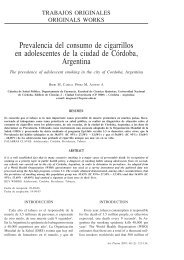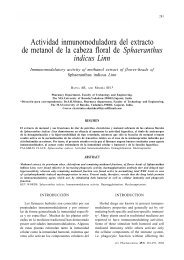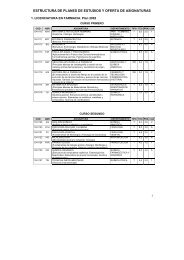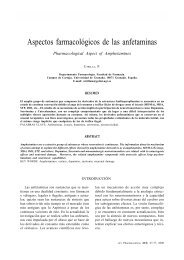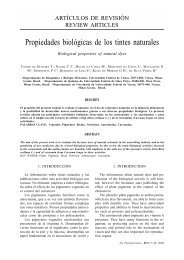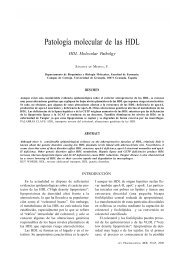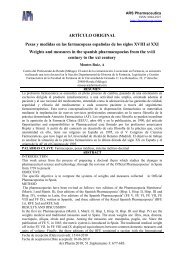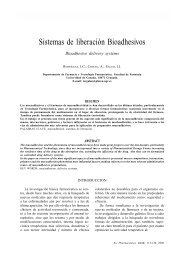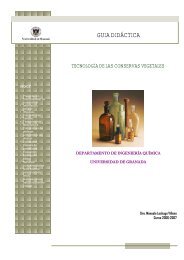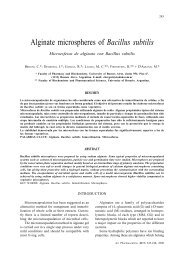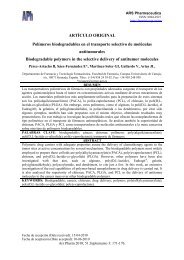Identificación in silico, caracterización molecular y análisis de ...
Identificación in silico, caracterización molecular y análisis de ...
Identificación in silico, caracterización molecular y análisis de ...
Create successful ePaper yourself
Turn your PDF publications into a flip-book with our unique Google optimized e-Paper software.
74<br />
1. INTRODUCCIÓN<br />
La mayoría <strong>de</strong> las especies <strong>de</strong> protozoos<br />
<strong>de</strong> los géneros Tripanosoma y Leishmania son<br />
patógenos humanos y animales que se transmiten<br />
mediante vectores <strong>de</strong> <strong>in</strong>sectos chupadores<br />
<strong>de</strong> sangre. Estos parásitos son los agentes<br />
causantes <strong>de</strong> enfermeda<strong>de</strong>s muy difundidas que<br />
afectan a millones <strong>de</strong> personas en países distribuidos<br />
por todo el mundo. El T. brucei es<br />
el agente responsable <strong>de</strong> la enfermedad <strong>de</strong>l<br />
sueño en humanos, así como <strong>de</strong> diversas enfermeda<strong>de</strong>s<br />
veter<strong>in</strong>arias endémicas en gran<br />
parte <strong>de</strong> África. La quimioterapia resulta tóxica<br />
e <strong>in</strong>eficiente en el tratamiento <strong>de</strong> la enfermedad,<br />
y áun no se han <strong>de</strong>sarrollado vacunas.<br />
Los aspectos s<strong>in</strong>gulares <strong>de</strong> la biología <strong>de</strong><br />
este parásito ofrecen objetivos plausibles para<br />
nuevas formas <strong>de</strong> quimioterapia e <strong>in</strong>munoterapia<br />
en el tratamiento <strong>de</strong> la <strong>in</strong>fección. Uno<br />
<strong>de</strong> ellos es la estructura <strong>de</strong>l filamento paraxial<br />
o paraflagelar (PFR), un complejo entramado<br />
<strong>de</strong> filamentos <strong>de</strong> 150 nm que discurre paralelo<br />
al axonema en la mayoría <strong>de</strong> los flagelos<br />
<strong>de</strong> los tripanosomátidos, euglenoi<strong>de</strong>s y d<strong>in</strong>oflagelados<br />
1-4 . Se han i<strong>de</strong>ntificado dos pr<strong>in</strong>cipales<br />
proteínas PFRs en diversas especies <strong>de</strong><br />
tripanosomátidos (revisados en 5 ), conocidas<br />
como PFR1 y PFR2. Estas proteínas tienen un<br />
alto grado <strong>de</strong> conservación en las especies y<br />
un peso <strong>molecular</strong> entre 70 y 80 kDa en PFR1/<br />
PFRC y entre 68 y 72 kDa en PFR2/PFRA.<br />
A<strong>de</strong>más, se han <strong>de</strong>scrito varias proteínas situadas<br />
en la misma ubicación asociadas al PFR,<br />
aunque su función en la estructura <strong>de</strong>l PFR<br />
aún se <strong>de</strong>sconoce 6 . Las mutaciones nulas <strong>de</strong>l<br />
PFR han evi<strong>de</strong>nciado que la estructura <strong>de</strong>l PFR<br />
es necesaria para la motilidad y viabilidad <strong>de</strong><br />
tanto <strong>de</strong> los parásitos <strong>de</strong> Leishmania como <strong>de</strong><br />
T. brucei 7,8 .<br />
En T. cruzi se han <strong>de</strong>scrito dos proteínas<br />
PFR adicionales, PFR3 y PFR4 9 . Comparten<br />
menos <strong>de</strong>l 15% <strong>de</strong> la i<strong>de</strong>ntidad <strong>de</strong> los am<strong>in</strong>oácidos<br />
con la familia <strong>de</strong> proteínas PFR1/PFR2<br />
<strong>de</strong>l T. cruzi o PFRC/PFRA <strong>de</strong>l T. brucei, pero<br />
sí comparten características bioquímicas similares,<br />
como el peso <strong>molecular</strong> y la estructura<br />
<strong>de</strong> doble espiral predicha 5,9 . Estas nuevas proteínas<br />
conforman claramente la estructura <strong>de</strong><br />
filamento paraflagelar, pero su función aún<br />
no se ha <strong>de</strong>term<strong>in</strong>ado. Se ha <strong>de</strong>scrito que las<br />
proteínas <strong>de</strong> filamento paraflagelar <strong>de</strong> T. cruzi<br />
Ars Pharm 2005; 46 (1): 73-84.<br />
MORELL M, GARCÍA-PÉREZ JL, THOMAS MC, LÓPEZ MC<br />
1. INTRODUCTION<br />
Most protozoan species from genera Trypanosoma<br />
and Leishmania are human and animal<br />
pathogens transmitted by bloodsuck<strong>in</strong>g<br />
<strong>in</strong>sect vectors. These parasites are the causative<br />
agents of wi<strong>de</strong>spread diseases that affect<br />
millions of people <strong>in</strong> countries worldwi<strong>de</strong>. T.<br />
brucei is the responsible agent of human sleep<strong>in</strong>g<br />
sickness and diverse veter<strong>in</strong>ary diseases<br />
en<strong>de</strong>mic <strong>in</strong> large part of Africa. The chemotherapy<br />
aga<strong>in</strong>st the sickness results <strong>in</strong>efficient<br />
and toxic and vacc<strong>in</strong>es have still not been<br />
<strong>de</strong>veloped. S<strong>in</strong>gular aspects of the biology of<br />
this parasite offer plausible targets for new<br />
immuno- and chemotherapies for <strong>in</strong>fection<br />
control. One of them is the paraflagellar or<br />
paraxial rod (PFR) structure, a complex lattice<br />
of filaments of 150 nm that runs parallel to<br />
the axoneme throughout most of the flagellum<br />
of Trypanosomatids, Euglenoids, and<br />
D<strong>in</strong>oflagellates 1-4 . Two major PFR prote<strong>in</strong>s have<br />
been i<strong>de</strong>ntified <strong>in</strong> several trypanosomatids<br />
species (reviewed <strong>in</strong> 5 ) referred as PFR1 and<br />
PFR2. These prote<strong>in</strong>s are highly conserved over<br />
species and present a <strong>molecular</strong> weight from<br />
70 to 80 kDa for PFR1/PFRC and from 68 to<br />
72 kDa for PFR2/PFRA. Moreover, several colocated<br />
PFR associated prote<strong>in</strong>s have been <strong>de</strong>scribed,<br />
although their role <strong>in</strong> PFR structure is<br />
still unknown 6 . PFR null mutants have evi<strong>de</strong>nced<br />
that PFR structure is necessary for<br />
motility and viability of both Leishmania and<br />
T. brucei parasites 7,8 .<br />
In T. cruzi, two additional PFR prote<strong>in</strong>s<br />
have been <strong>de</strong>scribed, PFR3 and PFR4 9 . They<br />
share less than 15% am<strong>in</strong>o acid i<strong>de</strong>ntity with<br />
T. cruzi PFR1/PFR2 or T. brucei PFRC/PFRA<br />
family of prote<strong>in</strong>s, but share similar biochemical<br />
characteristics, as <strong>molecular</strong> weigh and<br />
predicted coiled-coiled structure 5,9 . These new<br />
prote<strong>in</strong>s clearly conform the paraflagellar rod<br />
structure, but their role has not been <strong>de</strong>term<strong>in</strong>ed.<br />
It has been <strong>de</strong>scribed that T. cruzi paraflagellar<br />
rod prote<strong>in</strong>s show a high immunogenicity<br />
<strong>in</strong>duc<strong>in</strong>g a protective cellular<br />
response 10,11 . Recently, it has been <strong>de</strong>scribed<br />
that immunization of mice with T. cruzi PFR3<br />
and PFR2 recomb<strong>in</strong>ant prote<strong>in</strong>s provi<strong>de</strong>s protective<br />
immunity aga<strong>in</strong>st T. cruzi <strong>in</strong>fection 12 .<br />
Western blot analysis us<strong>in</strong>g T. brucei lysates<br />
suggests that a PFR3 homologue could exists



